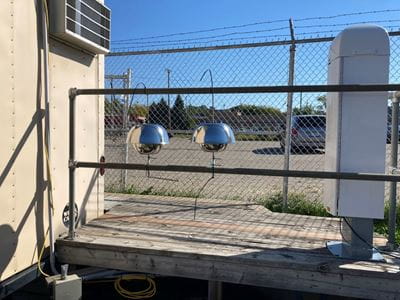The web Browser you are currently using is unsupported, and some features of this site may not work as intended. Please update to a modern browser such as Chrome, Firefox or Edge to experience all features Michigan.gov has to offer.
Air Quality Workgroup
Air Quality Workgroup
Mission
To review and share the current state of the science for PFAS in air and develop health-based screening levels for PFAS in air for the protection of public health and the environment. Identify PFAS use and sources of PFAS emissions, and regulate where authorized within established time frames for permitting and inspection activities.
The Air Quality Workgroup consists of staff from the Michigan Department of Environment, Great Lakes, and Energy (EGLE) and the Michigan Department of Health and Human Services.
Recent Accomplishments
- The definition of PFAS compounds continues to change as new studies of these compounds take place. Due to the variety of ways to define or describe what PFAS compounds are, MPART decided that having a working description of PFAS would be helpful as we try to understand the science behind PFAS. This description was developed in October 2023 and will be updated as science evolves. This definition will not be used to develop regulations.
PFAS Multi-State Air Quality Group
- In March of 2021, the Multi-State PFAS Air Group met with EPA ORD (Office of Research and Development) scientists to discuss and review OTM-45 (other test method), a new stack sampling methodology for PFAS, and a request was made for the states participating to provide test sites at which the method could be applied.
- On July 20, 2021, a speaker with the National Atmospheric Deposition Program (NADP) and Wisconsin’s DNR, presented on a workgroup call in which it was found that precipitation samples had levels of PFAS below 1 ppt.
- On March 9. 2022, the Multi-State Air Quality Group met to discuss definitions of PFAS.
- On July 28, 2022, a representative from New York Department of Conservation gave a presentation on a study evaluating PFAS emissions and deposition using soil testing and meteorological data for two facilities in their state.
- On November 29, 2022, a representative from the University of Rhode Island gave a presentation on the “proof of concept” PFAS passive air sampling conducted in Michigan during the Fall of 2021.
- As of November 2022, the workgroup included representatives from Illinois, Indiana, Massachusetts, Michigan, Minnesota, North Carolina, New Hampshire, New Jersey, New York, Ohio, Wisconsin, West Virginia, and California.
Harvard University and University of Rhode Island Collaborative Project
- Since early 2021, the workgroup has been in conversation with professors from the Harvard School of Engineering and Applied Sciences and the STEEP (Sources, Transport, Exposure, and Effects of PFAS) program at the University of Rhode Island (URI) about pursuing a joint project with MPART to investigate and develop a model for enhanced PFAS emissions inventories.
- This project used passive samplers developed at URI that took up PFAS from the air through diffusion. Data collected with the samplers will be used to evaluate Harvard’s model.
- A memorandum of understanding, a quality assurance plan, and standard operating procedures along with chain of custody documents were developed for the project.
- In the last week of September 2021, EGLE deployed 27 passive samplers in Michigan for one month. The University of Rhode Island analyzed the samples in 2022.
- In October of 2022, University of Rhode Island sent their final report titled, “Michigan PFAS Sampling at Air Monitoring Sites” and documented finding low levels of some PFAS compounds in the air at some locations similar to other outdoor semi-urban areas, and at concentrations lower than recently reported indoor air samples. This effort also showed that meaningful PFAS air samples can be taken using inexpensive equipment.
Image 1: Passive air sampler at site in Benzonia, MI
Image 2: Passive air samplers at site in Grand Rapids, MI
- Efforts to collect rainwater samples began in October of 2021. Samples were l collected from five different locations (Lansing, Saginaw, Grand Rapids, Traverse City, Southfield, and Bay City) and processed by MPART’s contractor. This rain bucket “proof of concept” study involved putting out inexpensive, PFAS-free rain buckets at the five locations and collected two to four rain events. Results showed very low levels of a few PFAS compounds in rain and that it is possible to collect PFAS rain samples inexpensively.
Image 3: Bucket placed outside during a rain event in Saginaw to collect rain samples to be tested for the presence of PFAS.
Next Steps
- Continue to communicate with other states and EPA about the best way to define, identify, monitor, reduce and control PFAS released into the air.
- Continue participating in quarterly EPA National Hazardous Waste Combustion calls.
- Continue to facilitate an MPART discussion group to develop a working description of PFAS.
- Continue to work on information collected from chromium electroplating facilities to identify PFAS use and alternatives.
Research/Studies
- Staff track the studies currently underway to monitor PFAS in the ambient air, test for PFAS emissions from point sources and understand the destruction of PFAS via incineration and discuss the status of this effort with EPA's Office of Research and Development scientists. Workgroup members with EGLE's Air Quality Division (AQD) develop human health screening levels for PFAS in air where appropriate to address human health and environmental concerns.
- Work with academic researchers to collect air and precipitation samples in support of atmospheric modeling in Michigan.
Timeline of Accomplishments
-
2018 - 2019
-
2020 - 2022


